A few weeks ago I came across a blog I didn’t want to leave for a very long time. Would you believe your luck if you discovered a treasury of detailed clear-cut instructions of how to teach children to draw illustrated with photographs of real-life works and accompanied with a printer-friendly version? Well, I couldn’t.
The blog "Art for Small Hands" is run by Julie Voigt who has taught art for over twenty-five years in public, private, and Montessori schools, both in the United States and Hong Kong. Julie has a degree in art education and her teaching experience spans pre-school children through eighth-grade. I am happy to have Julie as a guest.
Olga: Julie, I'm honoured to greet you at my website. You have extensive experience teaching art to children. Both the step-by-step instructions and your pupils' results that can be found on your blog show that you are somewhere near the heights of your profession. You seem to have learned the most important skill an educator can develop: an ability to learn from children. What do you mean by saying "What children know about art, grown artists are at pains to recapture. This is the joy of teaching art to children. It is also the great challenge."?
Julie: When I write “what children know about art,” I am referring to each child’s innate sense of art. Seeing the world through uninhibited eyes, children seem to have a natural sense of balance and order. As we grow older, we tend to lose this naturalness. The artist Pablo Picasso suggests this when he said, “Every child is an artist. The problem is how to remain an artist once he grows up.”
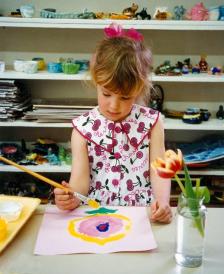
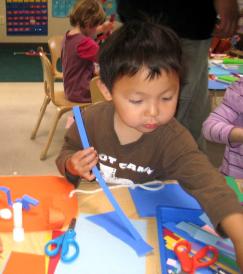
There is great joy in interacting with children, helping them to develop their creativity, and experiencing their unique solutions to assignments. The challenge is to teach without inhibiting their natural creativity – to find the right balance between providing instruction while still allowing freedom for each child to express his or her own vision. As instructors, we want to stir the children’s minds with ideas and teach them how to use materials in a way that does not hinder their abilities to think of their own solutions.
Olga: Ah, I see your point. Yes, I believe that if everyone had teachers thinking that way and acting accordingly, there would be a lot more artists among us people.
Julie, I continue reading the front page of your blog. You write: "Never start with a pre-cut shape. Never trace. Start from scratch. A child's circle will be more interesting than your own." Does it mean that you never use any stencils in your work with children?
Julie: Stencils actually serve the same purpose as pre-cut shapes. When children are learning to draw, why would you give them a shape to trace? Stencils give predetermined outcomes, not allowing the child to express his/her own solutions.
Olga: Julie, your answer set me thinking. My daughter has an animal stencil set and she uses it quite a lot in her drawing. It has always brought a smile to my face to see her tracing the shapes, then colouring them according to her own imagination and giving them to me as a present:
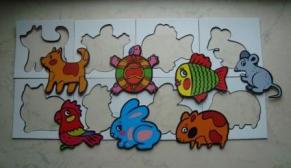
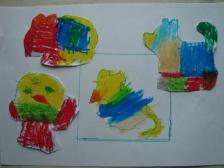
Do you think it prevents her from expressing her creativity to the full? What do you usually do when a child in your group expresses a desire to trace or copy something?
Julie: Your child's activity of tracing shapes is useful as an exercise to develop manual dexterity, but it is not art. Show your daughter a real fish and talk about its characteristics, such as fins, tail, scales, and round eyes. Then have her draw a fish as she interprets it - that is art.
When teaching art, I prepare the children to take on the task I have requested by giving them enough instruction to do the project without hindering their vision. If children want to trace or copy, I tell them that their interpretations are what we want to share. I convince them to try the project on their own and that I will be around to talk through any problems they may come across. Once the child gets started, I'm rarely called upon to intercede.
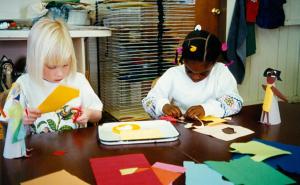

Olga: Oh, now I see the difference between art and reproduction. In fact we try different techniques which include painting from life. I'd like to show you two of the pictures my daughter has painted this way:
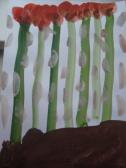
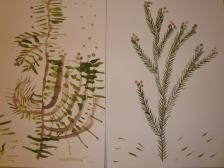
Julie, I used to take Dasha to drawing classes which both of us really enjoyed. The teacher put a sheet of paper on an easel in front of the children and they copied everything she did. The results were stunning: I had never seen my daughter create anything like that!
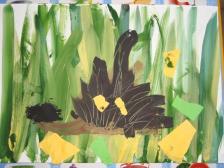
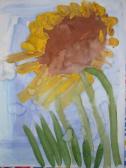
But now that I have started speaking to you I'm not sure any more whether it was the right way to teach children art. As far as I understood, you never ask your pupils to repeat brush strokes after you, do you?
Julie: I'm having trouble answering your question because the situation you describe is so far removed from how art should be taught. When I see the freedom and joy in Dasha's drawing of fern, I can't imagine guiding her to see the fern through someone else's eyes. No, I would never ask students to repeat brush strokes after me. Instead, I would teach the children the many ways that a paint brush can be used to create thick or thin lines, curvy or zigzag lines, broken or jagged lines. I would discuss the characteristics of the fern and then allow the children to paint their own vision.
Art is a process of self-expression where children explore and discover, producing unique and original results. Since each child is different, successful lessons need to allow for a wide variety of solutions. Guiding children with step-by-step instructions is uninspiring and a lost opportunity for the children to develop their own solutions. As science writer Roger Lewin said, "Too often we give children answers to remember rather than problems to solve."
Olga: Julie, you're opening my eyes to things that may look obvious to you.
What do you do while your students are creating their masterpieces? Let me guess. I can visualize you walking among the easels, giving them words of encouragement and always ready to answer their questions. Is it so?
Do you give your students feedback once a painting session is over? Do you explain what is technically wrong with their paintings? Do you sometimes criticize their works?
Julie: While the children are working, I travel around the classroom giving help and advice in the form of open-ended questions, encouraging the children to come up with their own answers and solutions. When the projects are completed, we display them so each child can tell us about his/her work. We discuss what worked best, what might have been done differently, and what the children learned in the lesson.
Olga: I'm glad I was right about your role as a teacher. 
As far as I know some art educators claim parents shouldn't interfere in their child's creative process by painting on the same sheet of paper. But my daughter and I like to paint together and we do it in quite a number of ways. Sometimes I begin and she continues, at other times she draws a picture and I colour it and so on.
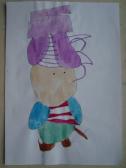
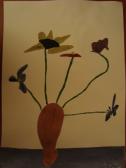
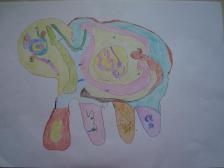
Julie, do you think joint adult and child painting is acceptable?
Julie: Spending time at home with your child and sharing activities is very rewarding for both of you. However, when teaching art in the classroom, working side-by-side with adults hinders the children's abilities to think of their own solutions - and worse, they often attempt to imitate the adult's vision at the expense of some wonderfully unique and charming art.
Olga: Julie, could you show your favourite works created by your students and say what you like about them, please?
Julie: Having taught art for almost 30 years, there are too many wonderful art works to choose a favorite. However, I can address a few of the most successful lessons.
Self-portraits - The children do exercises to learn about the proportions of their bodies and then draw self-portraits. Looking into mirrors, we discuss each child's individual characteristics like glasses, freckles, and hair type. The children take great pride in drawing their own images.
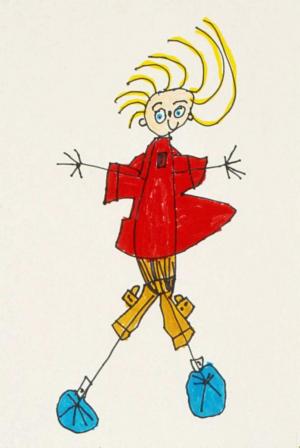
Drawing with contour lines - As fruit is cut or eaten, the children record changes in the contour lines. In this lesson, the children work from observation and loose any inhibition about drawing because they are having so much fun eating the fruit!

Papier Mache Hand Puppets - As the children work, they develop a personal attachment to their puppets and love planning a "puppet show" with the class.

Storytellers - In the tradition of the Pueblo Indians, the children make clay figures depicting storytellers passing along their legends while children gather round to listen.
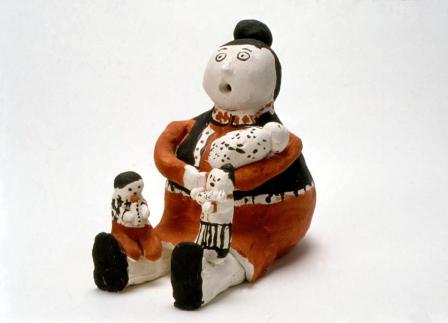
Note that in all of these lessons, the children's solutions to the assignments are unique and delightfully different.
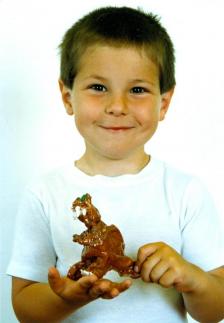

Olga: What a wonderful exhibition! My daughter and I are going to follow your detailed instructions to create our own works. And we’ll definitely start with self-portraits. In fact we have already begun. Yesterday Dasha painted her first portrait without following me or anyone else. After that she wanted me to paint her portrait and I did:

Julie, thank you very much for the time you took to answer my questions and for your blog. I’m going to print off and make use of your posts to help my daughter reveal her creativity to a greater extent.
I’d like to cite a book I’m reading at the moment:
“Young children are wonderfully confident in their own imaginations. Most of us lose this confidence as we grow up. Ask a class of first graders which of them thinks they’re creative and they’ll all put their hands up. Ask a group of college students this same question and most of them won’t. I believe passionately that we are all born with tremendous natural capacities, and that we lose touch with many of them as we spend more time in the world. Ironically, one of the main reasons this happens is education. The result is that too many people never connect with their true talents and therefore don’t know what they’re really capable of achieving. In that sense, they don’t know who they really are.” (“The Element” by Ken Robinson)
It occurred to me that waking up a person’s creativity can be considered in a wider sense and that your profession is not only about teaching art but about helping a person to discover their real talent.

Ольга, спасибо за интервью с чудесным художником - Педагогом с большой буквы. И хотя я читала интервью с помощью переводчика, основную идею мне удалось понять.
Нужно помогать ребенку раскрывать свой творческий талант, показывая разные техники и избегая копирования.
Понравились рекомендации по детальному обсуждению предметов рисования.
Понравились веселые "съедающиеся" рисунки.
Я, конечно, не педагог-художник, а просто мама и мне очень нравятся ваши совместные рисунки. Это так здорово - идти на одной волне со своим ребенком!
Ольга, желаю Вам творческих успехов с дочуркой, а Джулии - благодарных учеников!
Спасибо, Людмила! И вам с Олесей творческих успехов.
Этот разговор с Джули заново открыл для меня простые истины, от которых я начала уходить под влиянием разнородного опыта.
Оля, спасибо большое за это интервью! Советы этой женщины могут дать больше, чем иные дорогостоящие курсы по рисованию.
Я тоже сегодня рисовала портреты детей))) Может и они "созреют", глядя на меня
Мне еще интересно - Джули все-таки предлагает им сюжеты или только показывает техники, а сюжеты дети придумывают исключительно самостоятельно?
Оля, насколько я поняла, Джули предлагает детям сюжеты: каждое из описываемых в её блоге занятий посвящено отдельной теме и технике.
Но ты можешь спросить у неё сама, если сформулируешь вопрос на английском.